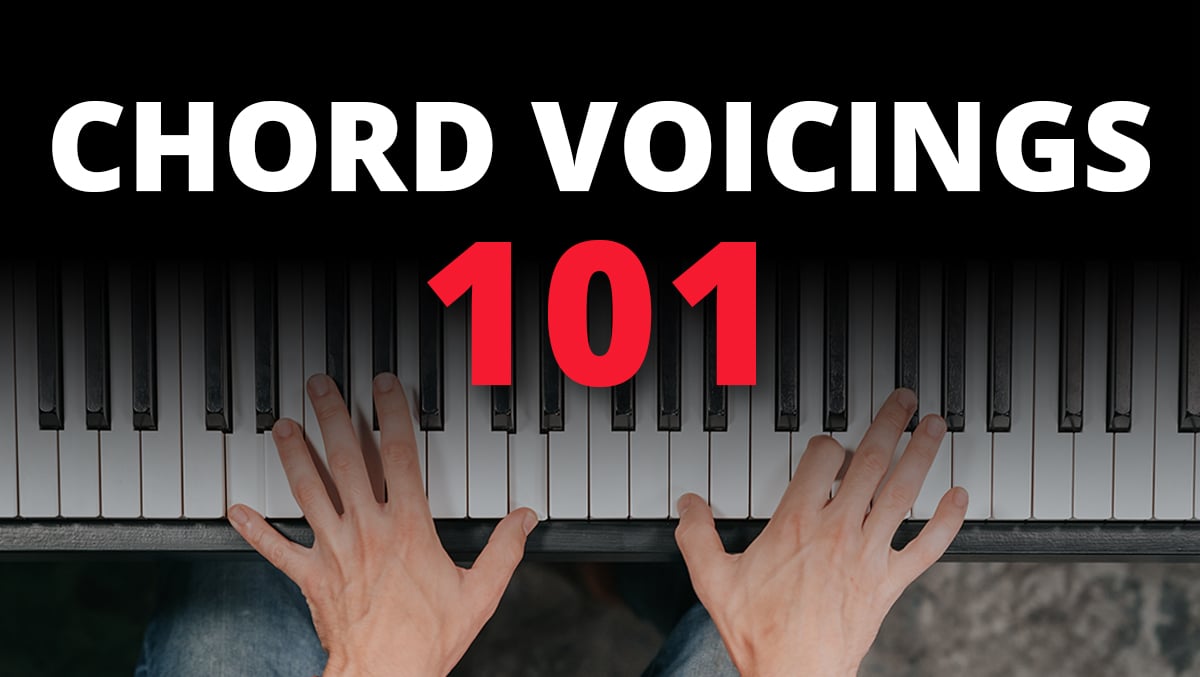
Did you know the same chord can sound a dozen different ways? That’s the magic of chord voicings. Voicing refers to how you arrange and distribute the notes of a chord across the keyboard. As a beginner, you probably learned chords in closed voicing, but there are also open voicings, rootless voicings, and more!
Here’s an introduction to chord voicings on the piano for beginners.
Table of Contents:
Subscribe to The Note for exclusive interviews, fascinating articles, and inspiring lessons delivered straight to your inbox. Unsubscribe at any time.
This is likely the first type of chord voicing you’ll learn. Closed voicing is when you play the notes of a chord close together, within an octave. Here’s the C major I-V-vi-IV progression in closed voicing with an extra root note in the bass.

Open voicing is when we spread the notes of the chords across a wider distance. This creates a fuller, more complex sound.

Sometimes, too many chord tones can sound muddy, especially if you’re accompanying yourself with chords in your left hand and the melody in your right.
One way to cut down on the muddiness is to use shell voicings. This is when you use the bottom and top notes of a chord and “outline” it. It’s a more open, sparser sound and is common in jazz.
Here’s an example of a ii7-V7-I7 progression in C major. The left hand plays shell voicings (root and seventh) while the right hand plays a simple scale. Notice that by retaining the root and seventh, we preserve the core quality of the chord.

There are endless ways to arrange chords to make interesting sounds. Once you’re comfortable with closed, open, and shell voicings, try these techniques.
Rootless voicings are exactly what they sound like: playing chords without the root note! This technique was made famous by legendary jazz pianist Bill Evans.
Here’s a ii7-V7-I7 chord progression in C major, with the root notes included:

Now here’s a typical rootless ii7-V7-I7 chord progression in C major. We often substitute the root note with an extension tone, like the 9th. Typically, rootless dominant 7th chords are played as 13ths.

Why use rootless voicings? In a jazz band, pianists often play the middle register while the bass player is in charge of the bass line. So, rootless voicings can help a band space out its sound without doubling on root notes.
A drop-2 voicing is when you take the second-highest note in a chord stack and drop it by an octave. For example, take this I-V-vi-IV progression in C major. The arrow points to the note that is second-highest.

We’ll drop this note to create an open, drop-2 voicing. Like this:

Similarly, we can drop both the second and fourth highest notes to create drop-2 and drop-4 voicings. This creates an even more open sound.

You may notice that I sometimes use inversions to write these chord progressions. While these techniques can work with root position chords, using inversions ensures good voice leading. Voice leading is when we try to transition between chords as smoothly as possible, moving our hands as little as we can.
We hope this post gives you a taste of the voicing opportunities that await you at the piano. Go try them out!
The best way to learn piano is with real teachers, but not everyone has the time and money for a private instructor. At Pianote, you can get real feedback from real experts…all from the comfort of your own home. Explore our Method and community yourself with a free 7-day trial.
TRY PIANOTE FOR 7 DAYSCharmaine Li is a Vancouver writer who has played piano for over 20 years. She holds an Associate diploma (ARCT) from the Royal Conservatory of Music and loves writing about the ways in which music—and music learning—affects the human experience. Charmaine manages The Note. Learn more about Charmaine here.


By signing up you’ll also receive our ongoing free lessons and special offers. Don’t worry, we value your privacy and you can unsubscribe at any time.
We use cookies for traffic data and advertising. Cookie Policy »